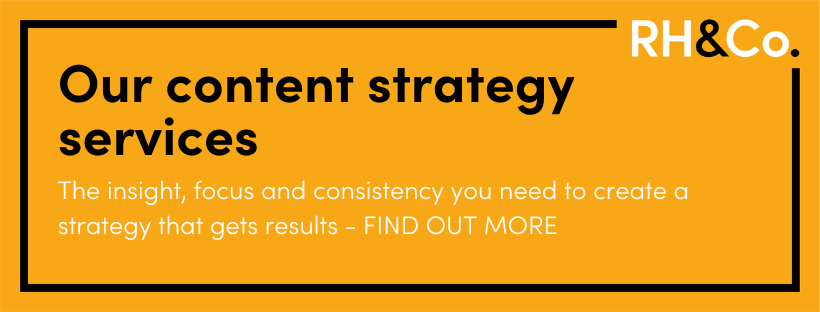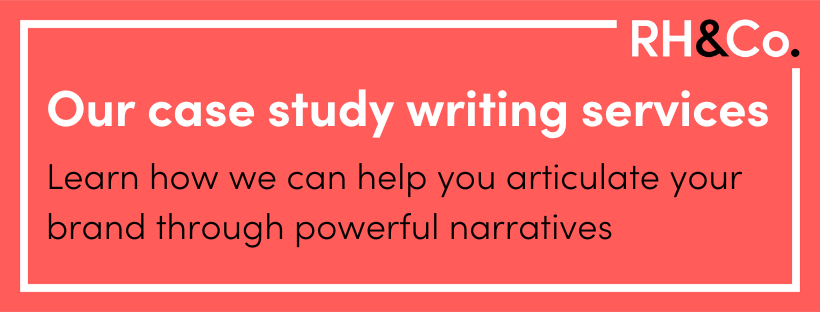

B2B content strategy and planning – ‘Ask me anything’ webinar with Rin Hamburgh
RH&Co founder, Rin Hamburgh, recently hosted an ‘Ask me anything’ webinar, answering your questions on all things B2B content strategy and planning for 2024. If you didn’t see it live, you can watch the video recording or, if you prefer your content in written format, have a look at the Q&A answer summaries below.
TL:DR
- What content should I prioritise if I have limited resources?
- What types of content are best outsourced vs done in-house?
- What’s the best way to measure how effective content is?
- Where should you publish blogs or articles – on your website or on a platform like LinkedIn, or Substack or Medium?
- What is the most common mistake you see people make with blogging (or content generally)?
- I’m struggling to get our technical experts involved in creating the content – do you‘ve any tips?
- Are case studies still useful content for B2B businesses, and if so, what format should they take?
- We have a big bank of podcast content – can we turn it into a blog series, and if so, how?
- What kind of content should you be sharing in a newsletter?
What content should I prioritise if I have limited resources?
Deciding what content to produce all starts with your business goals. Different types of content (and the different channels through which you can share them) are effective in different ways. So it’s important to understand what you’re looking to achieve – whether that’s scaling brand awareness, breaking into a new market, or increasing SQL conversions – so you can focus on the most appropriate content and channels.
You also need to understand what resources different types of content will require. For example, running paid ads requires a financial commitment over an extended period of time. On the other hand, posting regularly on LinkedIn takes time (and skill) but doesn’t necessarily have to cost anything.
In terms of putting all of this together into a strategy, think about your content priorities and frequency in terms of what LinkedIn’s Purna Virji calls ‘hum, sing and shout’ content:
- Hum: some lower level content to create consistency and maintain brand awareness over the long term.
- Sing: periodic small campaigns designed to achieve specific goals such as educating your audience on a key topic or going after a specific industry vertical.
- Shout: occasional hero content campaigns to support an important business objective such as a new product launch.
If you’re really pushed on resources and have to put all your eggs in one basket for the short term, think about where you can get the biggest wins most quickly. Do you have a large client database you could reach out to with a reintroduction or referral email campaign? Have you recently completed a prestigious project that you could use to create a case study or enter an award?

What types of content are best outsourced vs done in-house?
Naturally the biggest part of the decision about what content to outsource vs produce in-house is going to be what skills you and your team have. While many marketers have some practical delivery skills such as writing or design or videography, it’s likely you won’t be able to do all of them to the same standard as a specialist.
This might not be a problem. You’ll need to think about the standard required for your content. For example, if you’re filming an important explainer video, you might want a professional videographer involved. But if, like us, you’re doing a webinar Q&A, you can probably use the software on your laptop to film and edit it together on a shoestring.
What many of our clients do is engage us to create the larger, more complex pieces of content such as white papers or thought leadership articles, and then do the repurposing of that copy in-house to create social media content. In a similar way, you would need to get a design or branding agency involved in creating your visual branding in the first place, but could then go on to use that branding yourself to create ongoing design assets in-house.
What’s the best way to measure how effective content is?
Measuring content effectiveness starts with setting goals and then defining what metrics make most sense for that goal. Each type of content and each goal will have different metrics that you might want to track, so there’s no one best way. However, it’s important to think about two key things…
First, be specific. If you’re sharing thought leadership content on LinkedIn, don’t just look at how many impressions or engagements you’re getting. Think about whether you want those impressions and engagements to come from people in a particular industry sector or at a particular level of seniority, and track that.
Also, make sure your metrics are relevant. Taking the thought leadership example again, the likely goal for this is brand awareness. So measuring leads generated is probably a bit of a stretch. But if members of your expert or senior leadership team are invited to do a speaking engagement or be a guest on a podcast, that could be considered a relevant win.
Where should I publish blogs or articles – on our website or on a platform like LinkedIn, or Substack or Medium?
There are advantages and disadvantages to posting blogs or articles on a business website vs a social media platform like LinkedIn or a publishing platform like Substack or Medium.
One key issue is ownership. You own your website and therefore have control over it. Whereas on Substack, for example, the platform might disappear tomorrow, or it may require you to pay money in the form of promotions in order to get your articles in front of more people.
Posting to your website is also a way to attract people to that site, whether through SEO or organic social posting, where they can be exposed to more of your brand, products or services.
That said, not everyone is going to be willing to invest the time to click through to a post on your site – which psychologically feels like more of a commitment – whereas you might hold their attention for that bit longer if they can read within the platform they’re already on.
Ultimately your choice should be linked to your goals. If that goal is to raise your profile and grow your network within a given community, posting your content within that community can be very powerful. If, however, you want to drive traffic to your site and get people exploring your offering further, you might be better off posting the articles to your site and then sharing smaller snippets on social media.
This two pronged approach offers the best of both worlds, giving the browsers a taste of your brand and messaging while still allowing you to reap the benefits of hosting the larger content on your own site.
What is the most common mistake you see people make with blogging (or content generally)?
The biggest mistake we see people making with content is not thinking strategically enough about it. Often this shows up as writing about what they want to write about rather than considering what their audience wants to read about.
Another common issue is being too sales focused at the wrong time. You can’t write a top-of-funnel thought leadership piece and then follow up with a sales CTA like ‘book a demo’. It’s important to see content as a way of moving people along the customer journey, step by step.
A third mistake is giving up before they’ve invested enough time in content as a tactic. Content marketing can take time to build momentum – online marketing guru Neil Patel says you need to give it at least 6 to 9 months, while Joe Pulizzi, author of Content Inc, writes that it’s more like 12 to 18 months. It’s also not always easy to see the results on the bottom line, especially when it comes to brand building content, so make sure you set realistic and relevant goals that you can track your progress against.
I’m struggling to get our technical experts involved in creating the content – do you have any tips?
Getting subject matter experts involved in content creation can be difficult because they’re usually very busy and often feel they have better things to do. If they’re not sold on the idea of content, or marketing in general, you’ll need to start by making the case for why it’s important.
When they do get involved, make sure you’re not taking more of their time than you have to. Do your research and use whatever time they have available to get the information from them that only they can provide – the anecdotes, experiences and insights that are so important for expertise-based content.
We have a lot more tips on this subject in our blog post, ‘Involving experts in content creation: a guide for marketers’.
Are case studies still useful content for B2B businesses, and if so, what format should they take?
Absolutely. Case studies can be a very powerful tool for B2B marketers and sales people – particularly those in service businesses. They’re a way of demonstrating the value you offer in a real world context, and this is especially useful when your offering is complex or intangible.
Like testimonials, case studies let your customers talk on your behalf. If you say your product or services are effective, that’s one thing. If someone else says it, that’s much more impactful.
Also because human beings love stories, case studies are that much more engaging to read than a process document.
In terms of format, there are four key elements you need to include:
- A summary of who the client or customer is – their industry, size, business model, anything that will help your ideal target to see you’re a good fit for them too.
- The problem they were facing when they came to you. You might also want to describe what the real underlying problem turned out to be after your diagnosis.
- What you did to support the client in overcoming that challenge. Paint a picture of what it was like to buy from or work with you.
- The results you delivered. Sometimes these will be tangible and quantifiable, such as money saved or revenue increased, but your outcomes might not be so measurable. In that case you’ll need to include qualitative elements such as quotes from the client.
A final point: if your case studies are long, it can be helpful to include a summary of key points at the top of the page.

We have a big bank of podcast content – can we turn it into a blog series, and if so, how?
Repurposing content by translating it into a different format is a great way to maximise your return on investment. You can absolutely turn a podcast into a blog, with a different approach depending on what type of podcast it is.
For a host plus guest podcast: Usually these podcasts follow a Q&A format, which translates perfectly into the written form. Depending on the length of the podcast and the guest’s answers, it’s likely you’ll need to edit both questions and answers, making them more concise and suitable for a reading audience, rather than a listening one.
For a panel podcast: This is where you have several people all chatting about a particular subject. In this case, the subject matter is front and centre, so think about writing a blog post that addresses the topic, and use pulled quotes from the podcast to highlight key points. This sort of blog post will feel a lot like a newspaper or magazine article.
Using the full transcript: You can also publish the full transcript of the podcast. This doesn’t make it a blog post, but it can be helpful for those who have listened and want to go back to a certain point by searching for a keyword. It’s also super low effort – just get an AI translation tool and then go through to edit out the ‘ums’ and mistakes.
What kind of content should I be sharing in our company newsletter?
Newsletters are usually sent on a regular basis to a database of readers who have signed up to receive them, and the content tends to be informational, inspirational or otherwise valuable in some way, rather than overtly salesy.
In general, newsletters tend to fall into two main categories…
The first is the long form newsletter. This could include the whole text of a blog post, for example, so that those who are subscribed never miss a post. Or it could be a letter format written to the readership – essentially an article but with a more intimate feel, since it’s written for and to the members of a specific group.
The advantage of this sort of newsletter is that your reader doesn’t need to click through to a different location in order to read all of your content. All you have to do is convince them to open the email and start reading, and then keep them engaged.
The second type of newsletter is the roundup. This is where you have several different sections, each of which has a small amount of text and most likely a link or CTA button leading to more.
This is a great way to share on more than one topic without the newsletter becoming unwieldy. Your reader will feel that they can browse and choose just the items that interest them, clicking through if they are interested in finding out more. It can also be useful for personalising future content, using clicks as an indicator of interest.
Here’s what we include in the RH&Co’s The Right Words:
- Introduction – a chance to say hi and set out what’s in the rest of the newsletter
- Two blog posts – usually our most recent plus a popular one from the archives
- Word of the week – A favourite unusual word and its definition (this is a reader favourite!)
- Industry news – something we’ve read or watched that we think our readers will find helpful or interesting
- Our news – something we want to share, whether it’s an upcoming webinar or a new ebook
- Social link – A call to follow us on LinkedIn and see more of our content more regularly
Have you got a question?
Get in touch and let us know. We’ll be sure to update this article with relevant questions as often as we can!
Back to hompeage










